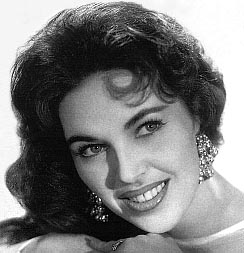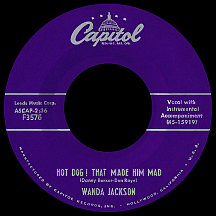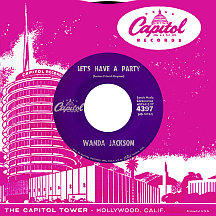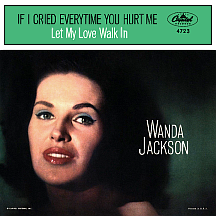WANDA JACKSON
A nice, innocent country girl from mid-state Maud, Oklahoma in Seminole territory had a protective father who aimed to keep her sheltered from a perilous world full of evil adults. Then Wanda Lavonne Jackson, who'd been a singer and musician since she was a child, became a recording artist at 16 and within a few years had developed a wild, "nasty" vocal sound (as even she referred to it), inviting everyone to party with her in downright flirty fashion. It was all part of an act synchronous with the rock and roll manner she assumed a couple of years into her career. Friend and tourmate Elvis Presley was the one who'd encouraged that visible wildness...the selfsame singer who would soon anger watchdog adults seeking to protect '50s youth from rioting as a result of this poisonous new music. If Wanda had been more successful in those early years, as a woman she would have likely been denounced even more than "The Pelvis" himself, yet she flew somewhat under the radar, walked a fine line between country, pop and rock, and ultimately gained the admiration of millions who consider her the greatest of rock and roll's early white female artists. All the while, she retained her values while navigating a lengthy career.
Her family made the difficult move from Maud to Los Angeles in 1941 when she was four years old; her father, Tom Jackson, had once sought a singing career but abandoned the competitive vocation in order to properly support his family. Taking note of his daughter's interest in music when she was about age six, he bought her a guitar from the Sears Roebuck catalog and she began practicing on this instrument that didn't amount to much more than a toy. Dad played fiddle and sang songs with his only child in the privacy of their home. Mom and dad went out dancing a lot and when babysitters weren't available they sometimes took her along. Mostly she just hugged the stage, fascinated with seeing some of the coolest country acts up close; the girl singers in Spade Cooley's group sparked her imagination and one band in particular, The Maddox Brothers and Rose (frontwoman Rose Maddox had quite a lively stage presence), made an impact on her. Later the family lived in Bakersfield, but by the time she was 12 they had made their way back eastward to Oklahoma City.
15-year-old Wanda entered and won a talent contest and for a time had her own daily show on an O.C. radio station, KPLR. Waco, Texas-based country star Hank Thompson, always on the lookout for fresh talent, invited her to perform with his band The Brazos Valley Boys. In the spring of 1954, while still in high school, she had a top ten country hit on the Decca label, "You Can't Have My Love," a duet with Brazos band guitarist Billy Gray; she did all the singing and he delivered a playboy-like monologue. Wanda had written several songs and one, "If You Knew What I Knew," appeared on the B side of her second single. These early tracks had strictly hillbilly arrangements with themes that fit the genre (she collaborated with C&W song specialist Cowboy Howard Vokes on "Tears at the Grand Ole Op'ry," the title alone making it easy to imagine how it sounds). Despite a demand for live shows, Wanda waited until she'd graduated from high school in 1955 to go on what might remotely be considered a performance tour. Her dad drove her from town to town while mom made a lot of the dresses Wanda wore onstage, some of which she designed; a more glamorous look was the goal, as she refused to adopt the "western-wear" outfits of the era's other female country singers (of which there were few).
Through Bob Neal's agency she received many small town bookings; in the summer of 1955 Neal was still managing Elvis Presley and Wanda wound up opening for the Sun Records artist who'd thus far had only limited regional success. She was greatly influenced by him as a singer and musician, her intense attraction part of the reason; dad did what he could to ward off any budding romance between the two. Even though Elvis had young women coming at him from all directions, the two dated whenever possible for about a year while touring together; he gave her a ring, which she wore on a chain around her neck (so there you have one theory as to the origin of Elvis's 1958 hit "Wear My Ring Around Your Neck"). He encouraged her to sing rock and roll and dad agreed it was the up-and-coming thing. Her brand of rock was bold for the time and not everyone approved, especially those approaching, say, the age of 30.
She was signed by Capitol Records that summer (Thompson was one of the label's top acts) and began to record rocking numbers with arrangements similar to those of labelmate Gene Vincent (also a recent signee), sometimes using the same studio musicians. "I Gotta Know" (written by singer-songwriter Thelma Blackmon) collated the two styles, moving from a rock-leaning tempo (with lyrics like 'So I boppity-bop the whole night long to the knocked-out music of a jukebox song...') to a slower fiddling country feel ('If our love's the real thang, where is my weddin' ring?') and back again. The single reached number 15 on Billboard's Most Played C&W by Disc Jockeys chart in October 1956. Follow-up efforts had a sexy rock and roll vibe; "Hot Dog! That Made Him Mad" (big band composers Danny Barker and Don Raye wrote it) confirmed her flirtatious wickedness (...late last night when I came in, he demanded to know just where I'd been...but I really put him right in his place, instead of an answer I laughed in his face...'), if only on record and stage.
For a time, Capitol coupled each record with a country-style song on one side and a rocker on the other ("Baby Loves Him" and "Cool Love" were Jackson originals, the latter cowritten with another early female songwriter, Vicki Countryman). Sometimes the A and B side formula was modified, as in the combination of "Let Me Explain," an R&B ballad originated by Chuck Willis, and Boudleaux Bryant's calypso-influenced "Cool Love." The craziest song of all, perhaps, was "Fujiyama Mama," penned by Earl Burroughs (a.k.a. Jack Hammer), somewhat shockingly featuring Wanda's growling swagger: "I've-a been to Nagasaki, Hiroshima too...the thing I did to them, baby, I can do to you!' You would think these lyrics, coming just 12 years after the U.S. had dropped atomic bombs on the cities in question, would be offensive to the people of Japan, but there was no need for concern; it was a hit there and created a strong demand for her to mount concert tours, which she did...several times.
Despite the limited popularity of these frenzied discs that were harder-hitting than what other women were attempting, Wanda persisted with Capitol's approval. Her own composition, "Mean Mean Man," came along in the fall of '58 with a driving beat but a peculiar attitude about what constitutes a mean dude: '...now he calls at seven, wants a date at eight, never on time, he's always late...now we go to a dance, he holds me tight, but then he don't even kiss me goodnight!' Two years later American radio listeners were treated to the ultimate Wanda J. rocker, a song by Jessie Mae Robinson (who'd been writing hit jazz and R&B songs since the mid-'40s) recorded by Elvis in '57 as "Party." Jackson's "Let's Have a Party" rendered Presley's version tame by comparison; "I never kissed a bear, I never kissed a goon...but I can shake a chicken in the middle of the room!' is delivered with such assertive rasp that it's hard to envision anything but a graphically literal translation of the line. The single reached the national top 40 in October 1960 and is considered Wanda's all-time classic recording.

1961 was a year of changes. She married Wendell Goodman, who quit his lucrative job at BMI to manage her career, though unlike many other marriage/management situations, this one actually worked. After such a long struggle getting her first top 40 hit, Wanda was lured by the shift in country and western to more of a pop sensibility typified by the hits of Patsy Cline. She wrote a ballad with Brenda Lee in mind, but producer Ken Nelson convinced her to keep "Right or Wrong" for herself. The song made the Billboard top 30 and entered the country top ten late in the summer (the first to reach that level since her debut single). "In the Middle of a Heartache" ('...half out, half in...'), a similar effort written by Wanda with Pat Franzese and Laurie Christenson, became her highest-charting single, peaking at number six country while returning her to the pop top 30 in December.
Two singles peaked at lower positions on the Hot 100 in 1962: a cover of Burl Ives' Hank Cochran-created hit "A Little Bitty Tear" and the Harlan Howard ballad "If I Cried Every Time You Hurt Me." Soft, heartbreaking songs became her trademark over the next few years; Mel Tillis's tune "The Violet and a Rose" placed her in the country top 40 in the spring of '64. Soon after, she received her first of two Grammy nominations for the Two Sides of Wanda Jackson LP in the category Best Country and Western Vocal Performance, Female; the other four nominees were cited for individual songs and the award went to Dottie West for her breakthrough '64 solo hit "Here Comes My Baby." Then in a surprising departure, she recorded a German language rendition of "Santo Domingo" (Bert Olden and Joachim Relin were the credited songwriters, though others claimed authorship for various translations). Capitol released it in Germany, where it became a major hit in 1965.
In 1966, "The Box it Came In" (by Vic McAlpin, who'd written for many top stars) hit the country top 20 and started Wanda on a nonstop, five-year run of hits, many of them ballads. Highlights include "Tears Will Be the Chaser for Your Wine," "Both Sides of the Line" and "A Girl Don't Have to Drink to Have Fun" in 1967 (singles from '67 and '68 gave credit to her backing band, The Party Timers). The softly-threatening "My Big Iron Skillet" in '69 preceded a second Grammy nomination for the 1970 hit "A Woman Lives for Love." This time Lynn Anderson won, her crossover country/pop smash "Rose Garden" proving insurmountable. Of 30 charting country singles, 1971's "Fancy Satin Pillows" put Wanda's total of top 20-ranked hits at nine.
She made TV appearances from time to time (a few early-'70s Hee Haw appearances are memorable) and remained with Capitol until 1973, then switched her preference to songs of faith, recording several spiritual albums that took her through the remainer of the decade. Her final charted single was "Come on Home (To This Lonely Heart)" in 1974. The popularity of early American rock and roll had sparked a massive European "rockabilly" revival in the '70s and by the early 1980s Wanda, looking fantastic in her mid-forties, began performing in the U.K. and other countries, reviving her wild, flirtatious rock persona as stimulation for a new generation of fans and older rockers too. She toured the U.S. in the '90s with rock and roll/western swing revivalist Rosie Flores, who counted Wanda among her prime influences. Another career resurgence occurred in 2010; a comeback album featured Jack White of The White Stripes and her "nasty" vocal sound came through loud and clear on several tracks! Wanda Jackson's long, eventful career was summed up by its title: The Party Ain't Over. May it never end!
NOTABLE SINGLES:
- You Can't Have My Love - 1954
by Wanda Jackson and Billy Gray - If You Knew What I Knew - 1954
- Tears at the Grand Ole Op'ry - 1955
- I Gotta Know - 1956
- Hot Dog! That Made Him Mad - 1956
- Baby Loves Him - 1957
- Let Me Explain /
Don'a Wan'a - 1957 - Cool Love - 1957
- Fujiyama Mama - 1958
- Honey Bop - 1958
- Mean Mean Man - 1958
- Let's Have a Party - 1960
- Riot in Cell Block Number Nine - 1961
- Right or Wrong - 1961
- In the Middle of a Heartache - 1961
- A Little Bitty Tear - 1962
- If I Cried Every Time You Hurt Me - 1962
- I Misunderstood - 1962
- The Greatest Actor - 1962
- The Violet and a Rose - 1964
- Santo Domingo - 1965
- The Box it Came In - 1966
- Because it's You - 1966
- This Gun Don't Care - 1966
- Tears Will Be the Chaser for Your Wine - 1967
- Both Sides of the Line - 1967
as Wanda Jackson and the Party Timers - A Girl Don't Have to Drink to Have Fun - 1967
as Wanda Jackson and the Party Timers - By the Time You Get to Phoenix - 1968
as Wanda Jackson and the Party Timers - My Baby Walked Right Out on Me - 1968
as Wanda Jackson and the Party Timers - If I Had a Hammer - 1969
- My Big Iron Skillet - 1969
- Two Separate Bar Stools - 1969
- A Woman Lives for Love - 1970
- Fancy Satin Pillows - 1971
- Back Then - 1971
- I Already Know (What I'm Getting for My Birthday) - 1972
- Come on Home (To This Lonely Heart) - 1974




